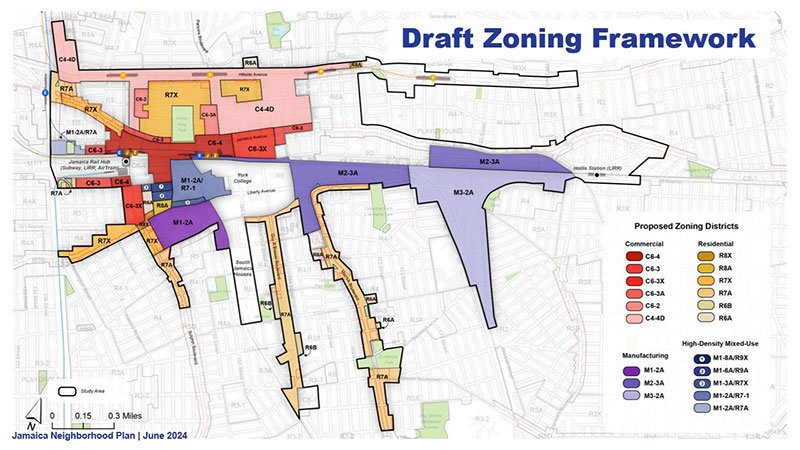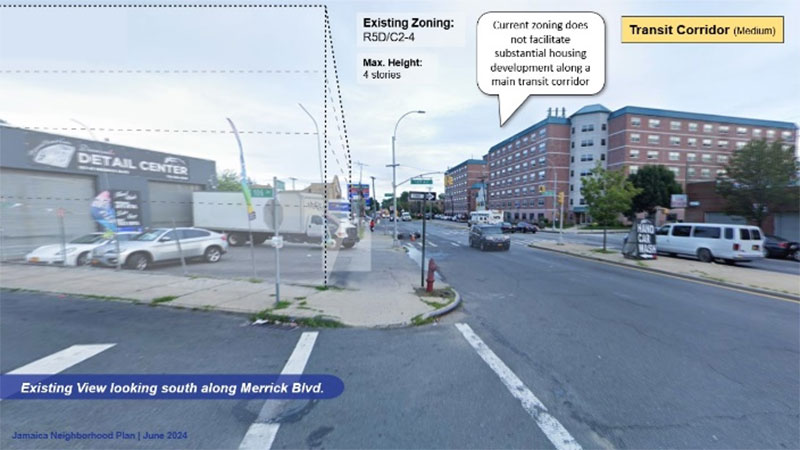
 Department of City Planning311
Department of City Planning311 Search all NYC.gov websites
Search all NYC.gov websites
Press Releases
For Immediate Release
June 14, 2024
Contacts:
Casey Berkovitz, Joe Marvilli – press@planning.nyc.gov (212) 720-3471
City Planning Takes Next Step Toward New Housing, Jobs, Open Space and Streetscape Improvements in Jamaica, Queens
Draft Zoning Proposal Could Enable Nearly 12,000 New Homes, including Nearly 3,000 Affordable
Rezoning Advances Toward ULURP with Start of Environmental Review

A map of the new districts in the draft zoning proposal for the Jamaica Neighborhood Plan.
Download this image and other illustrations of the plan here.
NEW YORK – New York Department of City Planning (DCP) Director Dan Garodnick today released the draft zoning proposal for the Jamaica Neighborhood Plan. Building on more than a year of public outreach and feedback from thousands of New Yorkers, the draft zoning proposal and policy strategies would build on the strengths of this vibrant Queens neighborhood to enable up to 11,759 new homes, including 2,984 income-restricted affordable homes through Mandatory Inclusionary Housing (MIH), and grow the local economy with 1.4 million square feet of commercial space, 864,000 square feet of community facility space, and nearly 15,000 square feet of industrial space. The Jamaica Neighborhood Plan will also advance non-zoning strategies to support the local community, including infrastructure investments, improved transit access and open space, job training, support for cultural institutions and faith-based organizations, and more.
“Jamaica is a vibrant neighborhood that deserves affordable housing, jobs, and investments in open space, streetscapes, resiliency, and more. This bold draft zoning proposal truly meets those community goals. With tailored approaches for each part of this transit-accessible neighborhood, we’re ready to move ahead towards an even brighter, stronger future for Jamaica – one that unlocks its limitless potential,” said Department of City Planning Director Dan Garodnick.
“Investing in the vibrancy and success of Jamaica through a long-term, community-driven vision is pivotal to the prosperity of Southeast Queens and to our entire city,” said Speaker Adrienne Adams. “The draft proposal for the Jamaica Neighborhood Plan was shaped and crafted by the input of thousands of community residents, whose engagement throughout this process has been inspiring. Advancing opportunities for new affordable housing, infrastructure investments, economic growth, and neighborhood facilities can impact our communities for generations to come. I look forward to continued participation and engagement from our neighbors through this planning process.”
"As we release the draft zoning framework for the Jamaica Neighborhood Plan, we are taking a crucial step towards understanding the impact of additional housing on our local schools, traffic, public spaces, and infrastructure. Our goal is to create more affordable housing while ensuring that we invest in the quality of life for all residents. This study will allow us to make informed decisions that support a thriving, inclusive, and sustainable Downtown Jamaica for generations to come. I look forward to incorporating even more of the voices of the community as this plan and study progresses,” said Council Member Nantasha Williams.
"Today's release of the draft zoning proposal for the Jamaica Neighborhood Plan marks a pivotal step towards the revitalization of Jamaica. This plan is the culmination of extensive public engagement and reflects the input of thousands of New Yorkers. I encourage all to attend the July 11 meeting, which will give the community the crucial opportunity to chime in on the environmental impact of this project,” said Council Member James F. Gennaro.
“Jamaica has long been one of our city’s most iconic, diverse and culturally significant neighborhoods, but institutional challenges have prevented it from reaching its full potential. Our draft Jamaica Neighborhood Plan will help unlock that potential and uplift the countless families who live, work and play here,” said Queens Borough President Donovan Richards Jr. “As a proud son of this community, I’m deeply grateful to the Department of City Planning, my elected colleagues and all our neighbors who have shepherded the plan to this point. From more affordable housing to more good-paying jobs to better mass transit, this is exactly the kind of investment Jamaica families deserve.”
The draft zoning proposal, first discussed with the Jamaica community at a virtual town hall on Thursday evening, accompanies the release of the draft scope of work, a significant milestone at the start of the environmental review process for an eventual rezoning proposal. It builds on input from thousands of New Yorkers and more than a year of community engagement, including a steering committee of local leaders, 26 events, and an online survey to hear about New Yorkers’ experience of Jamaica and vision for its future.
Building on that public input, the draft zoning proposal offers tailored zoning approaches to each part of the study area: the Downtown Core, Downtown Extension, Transit Corridors, and Industrial Growth areas. In the Downtown Core, along Jamaica Avenue and Archer Avenue, the draft zoning proposal would allow the highest density, with both commercial and residential uses permitted. Further north, between Jamaica Avenue and Hillside Avenue, these densities would step down slightly. In the Transit Corridors, along Hillside Avenue, western Jamaica Avenue, Liberty Avenue, Sutphin Boulevard, Guy R. Brewer Boulevard, and Merrick Boulevard, the draft zoning proposal would foster mixed-use, mid-rise development with locally-serving retail and community facilities. Further east, the Downtown Extension would encourage mixed-use development adjacent to world-class transit resources with housing, commercial, and light manufacturing job-generating uses. In the Industrial Growth area, the draft zoning proposal would use the newly created “Growth” manufacturing zoning district to support new employment and local businesses.


A photo of the existing conditions and an illustrative view of what could be built under the draft zoning framework. To download these images and similar illustrations elsewhere in Jamaica, click here.
Following the release of the draft scope of work, DCP will hold a scoping meeting on July 11 where New Yorkers can weigh in on the environmental review for the project. Following that meeting, DCP will conduct an environmental review to further inform the Jamaica Neighborhood Plan and release a draft environmental impact statement (DEIS) before certifying to begin New York’s Uniform Land Use Review Procedure (ULURP) next year. Once certified, ULURP is a roughly seven-month process where the community board, borough president, City Planning Commission, and City Council will be able to offer recommendations and ultimately vote on a proposed rezoning.
The Jamaica Neighborhood Plan is just one of a number of transformative initiatives advanced by the Adams administration to grow the economy and deliver the housing New Yorkers need. City of Yes for Housing Opportunity, a citywide zoning text amendment to enable a little more housing in every neighborhood, is currently being reviewed by community boards and borough presidents, and is anticipated to come to a vote before the end of the year. Additionally, in areas where more significant zoning changes may be appropriate in addition to City of Yes’s incremental citywide changes, DCP is also advancing four other neighborhood plans: the Bronx Metro-North Station Area Plan, the Atlantic Avenue Mixed-Use Plan, the Long Island City Neighborhood Plan, and the Midtown South Mixed-Use Plan.
The Adams administration also recently enacted the Green Fast Track, a streamlined environmental review process for climate-friendly housing, and is advancing the “24 in ‘24” initiative, creating 100% income-restricted affordable housing on city-owned land. These initiatives build on the administration’s successful advocacy in Albany, where all four of its housing policy planks were in enacted in the state budget, including tax incentives for mixed-income affordable housing and office-to-residential conversions. The administration is also providing faith-based organizations in Jamaica and across New York City with the education and resources they need to launch their affordable housing projects and connections to experts to guide them through the development process, through the New York City Mayor’s Office of Faith-Based and Community Partnerships and the Adams administration’s Working Group on Faith-Based Affordable Housing and Community Development.
Department of City Planning
The Department of City Planning (DCP) plans for the strategic growth and development of the City through ground-up planning with communities, the development of land use policies and zoning regulations applicable citywide, and its contribution to the preparation of the City’s 10-year Capital Strategy. DCP promotes housing production and affordability, fosters economic development and coordinated investments in infrastructure and services, and supports resilient, sustainable communities across the five boroughs for a more equitable New York City.
In addition, DCP supports the City Planning Commission in its annual review of approximately 450 land use applications for a variety of discretionary approvals. The Department also assists both government agencies and the public by advising on strategic and capital planning and providing policy analysis, technical assistance and data relating to housing, transportation, community facilities, demography, zoning, urban design, waterfront areas and public open space.


